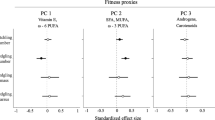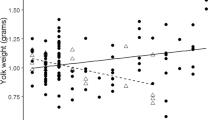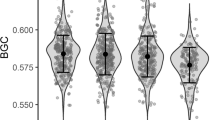Abstract
The hormonal environment during early development, such as maternally derived androgens in bird eggs, shapes the development of the offspring in ways that may have important long-term consequences for phenotype and behavior and, ultimately, fitness. We studied the long-term effects of yolk androgens on several phenotypic and physiological traits in male and female pied flycatchers (Ficedula hypoleuca) by experimentally elevating yolk androgen levels and rearing birds in common-garden environment in captivity. We found that high yolk androgen levels increased the basal metabolic rates in both females and males in adulthood. High yolk androgen levels did not affect male melanin coloration or plumage ornaments, or timing or speed of moult in either sex. No effect of androgen treatment on cell-mediated or humoral immune response was found in either sex. Covariation among the measured phenotypic traits was further not altered by androgen treatment. Our results suggest that exposure to high androgen levels can have long-lasting effects on some offspring traits, but do not seem to lead to different phenotypes. Furthermore, the role of yolk androgens affecting sexually selected male traits in our study species seems to be minor. The fitness consequences of yolk androgen-induced higher metabolic rates remain to be studied.

Similar content being viewed by others
References
Andersson M (1986) Evolution of condition-dependent sex ornaments and mating preferences—sexual selection based on viability differences. Evolution 40:804–816
Andersson S, Uller T, Lohmus M, Sundström F (2004) Effects of egg yolk testosterone on growth and immunity in a precocial bird. J Evol Biol 17:501–505
Barja G (2007) Mitochondrial oxygen consumption and reactive oxygen species production are independently modulated: implications for aging studies. Rejuv Res 10:215–223
Bernardo J (1996) Maternal effects in animal ecology. Am Zool 36:83–105
Bonisoli-Alquati A, Matteo A, Ambrosini R, Rubolini D, Romano M, Caprioli M, Dessi-Fulgheri F, Baratti M, Saino N (2011a) Effects of egg testosterone on female mate choice and male sexual behavior in the pheasant. Horm Behav 59:75–82
Bonisoli-Alquati A, Rubolini D, Caprioli M, Ambrosini R, Romano M, Saino N (2011b) Egg testosterone affects wattle color and trait covariation in the ring-necked pheasant. Behav Ecol Sociobiol 65:1779–1790
Buchanan KL, Evans MR, Goldsmith AR, Bryant DM, Rowe LV (2001) Testosterone influences basal metabolic rate in male house sparrows: a new cost of dominance signalling? Proc R Soc Lond B 268:1337–1344
Buttemer WA, Warne S, Bech C, Astheimer LB (2008) Testosterone effects on avian basal metabolic rate and aerobic performance: facts and artefacts. Comp Biochem Physiol A 150:204–210
Carere C, Balthazart J (2007) Sexual versus individual differentiation: the controversial role of avian maternal hormones. Trends Endocr Met 18:73–80
Clotfelter ED, O’Neal DM, Gaudioso JM, Casto JM, Parker-Renga IM, Snajdr EA, Duffy DL, Nolan V, Ketterson ED (2004) Consequences of elevating plasma testosterone in females of a socially monogamous songbird: evidence of constraints on male evolution? Horm Behav 46:171–178
Costantini D (2008) Oxidative stress in ecology and evolution: lessons from avian studies. Ecol Lett 11:1238–1251
Cucco M, Guasco B, Malacarne G, Ottonelli R, Tanvez A (2008) Yolk testosterone levels and dietary carotenoids influence growth and immunity of grey partridge chicks. Gen Comp Endocr 156:418–425
Drost R (1936) Über das Brutkleid männlicher Trauerfliegenfänger, Muscicapa hypoleuca (Pall.). Vogelzug 6:179–186
Dufty AM, Clobert J, Møller AP (2002) Hormones, developmental plasticity and adaptation. Trends Ecol Evol 17:190–196
Duttmann H, Dieleman S, Groothuis TGG (1999) Timing of moult in male and female shelducks Tadorna tadorna: effects of androgens and mates. Ardea 87:33–39
Eaton MD, Lanyon SM (2003) The ubiquity of avian ultraviolet plumage reflectance. Proc R Soc Lond B 270:1721–1726
Eeva T, Hasselquist D, Tummeleht L, Nikinmaa M, Ilmonen P (2005) Pollution related effects on immune function and stress in a free-living population of pied flycatcher Ficedula hypoleuca. J Avian Biol 36:405–412
Eising CM, Visser GH, Müller W, Groothuis TGG (2003) Steroids for free? No metabolic costs of elevated maternal androgen levels in the black-headed gull. J Exp Biol 206:3211–3218
Eising CM, Müller W, Groothuis TGG (2006) Avian mothers create different phenotypes by hormone deposition in their eggs. Biol Lett 2:20–22
Forslund P, Pärt T (1995) Age and reproduction in birds—hypotheses and tests. Trends Ecol Evol 10:374–378
Galloway LF (2005) Maternal effects provide phenotypic adaptation to local environmental conditions. New Phytol 166:93–99
Gil D (2008) Hormones in avian eggs: physiology, ecology and behavior. Adv Stud Behav 38:337–398
Gil D, Graves J, Hazon N, Wells A (1999) Male attractiveness and differential testosterone investment in zebra finch eggs. Science 286:126–128
Gil D, Ninni P, Lacroix A, De Lope F, Tirard C, Marzal A, Moller AP (2006) Yolk androgens in the barn swallow (Hirundo rustica): a test of some adaptive hypotheses. J Evol Biol 19:123–131
Ginn HB, Melville DS (1983) Moult in birds. British Trust for Ornithology, Tring
Groothuis TGG, Schwabl H (2008) Hormone-mediated maternal effects in birds: mechanisms matter but what do we know of them? Philos T Roy Soc B 363:1647–1661
Groothuis TGG, von Engelhardt N (2005) Investigating maternal hormones in avian eggs: measurement, manipulation, and interpretation. Ann NY Acad Sci 1046:168–180
Groothuis TGG, Müller W, von Engelhardt N, Carere C, Eising C (2005) Maternal hormones as a tool to adjust offspring phenotype in avian species. Neurosci Biobehav R 29:329–352
Hall PF (1969) Hormonal control of melanin synthesis in birds. Gen Comp Endocr 2:451–458
Hamilton WD, Zuk M (1982) Heritable true fitness and bright birds—a role for parasites. Science 218:384–387
Hasselquist D, Nilsson JA (2009) Maternal transfer of antibodies in vertebrates: trans-generational effects on offspring immunity. Philos T Roy Soc B 364:51–60
Ilmonen P, Hasselquist D, Langefors A, Wiehn J (2003) Stress, immunocompetence and leukocyte profiles of pied flycatchers in relation to brood size manipulation. Oecologia 136:148–154
Jacquin L, Lenouvel P, Haussy C, Ducatez S, Gasparini J (2011) Melanin-based coloration is related to parasite intensity and cellular immune response in an urban free living bird: the feral pigeon Columba livia. J Avian Biol 42:11–15
Jenni L, Winkler R (1994) Moult and ageing of European passerines. Academic, London
Ketterson ED, Nolan V, Wolf L, Ziegenfus C (1992) Testosterone and avian life histories—effects of experimentally elevated testosterone on behavior and correlates of fitness in the dark-eyed junco (Junco hyemalis). Am Nat 140:980–999
Laaksonen T, Adamczyk F, Ahola M, Möstl E, Lessells CM (2011) Yolk hormones and sexual conflict over parental investment in the pied flycatcher. Behav Ecol Sociobiol 65:257–264
Lehikoinen E (2001) Varpuslintujen sulkasadon tutkimus. Moult of Finnish passerines—an overview. Linnut-vuosikirja 2000. BirdLife Suomi, Helsinki, pp 55–65
Lehtonen PK, Primmer CR, Laaksonen T (2009) Different traits affect gain of extrapair paternity and loss of paternity in the pied flycatcher, Ficedula hypoleuca. Anim Behav 77:1103–1110
Lessells CM, Boag PT (1987) Unrepeatable repeatabilities—a common mistake. Auk 104:116–121
Littell RC, Milliken GA, Stroup WW, Wolfinger RD (2006) SAS system for mixed models. SAS Institute Inc., Cary
Lundberg A, Alatalo R (1992) The pied flycatcher. Poyser, London
Martin LB, Han P, Lewittes J, Kuhlman JR, Klasing KC, Wikelski M (2006) Phytohemagglutinin-induced skin swelling in birds: histological support for a classic immunoecological technique. Funct Ecol 20:290–299
McKechnie AE (2008) Phenotypic flexibility in basal metabolic rate and the changing view of avian physiological diversity: a review. J Comp Physiol B 178:235–247
McNab BK (1997) On the utility of uniformity in the definition of basal rate of metabolism. Physiol Zool 70:718–720
Metcalfe NB, Alonso-Alvarez C (2010) Oxidative stress as a life-history constraint: the role of reactive oxygen species in shaping phenotypes from conception to death. Funct Ecol 24:984–996
Michl G, Török J, Péczely P, Garamszegi LZ, Schwabl H (2005) Female collared flycatchers adjust yolk testosterone to male age, but not to attractiveness. Behav Ecol 16:383–388
Moreno J, Morales J, Lobato E, Merino S, Tomas G, Martinez-de la Puente J (2005) Evidence for the signaling function of egg color in the pied flycatcher Ficedula hypoleuca. Behav Ecol 16:931–937
Mousseau TA, Fox CW (1998) Maternal effects as adaptations. Oxford University Press, New York
Müller W, Eens M (2009) Elevated yolk androgen levels and the expression of multiple sexually selected male characters. Horm Behav 55:175–181
Müller W, Deptuch K, Lopez-Rull I, Gil D (2007) Elevated yolk androgen levels benefit offspring development in a between-clutch context. Behav Ecol 18:929–936
Müller W, Vergauwen J, Eens M (2008) Yolk testosterone, postnatal growth and song in male canaries. Horm Behav 54:125–133
Müller W, Vergauwen J, Eens M (2009) Long-lasting consequences of elevated yolk testosterone levels on female reproduction. Behav Ecol Sociobiol 63:809–816
Navara KJ, Mendonça MT (2008) Yolk androgens as pleiotropic mediators of physiological processes: a mechanistic review. Comp Biochem Physiol A 150:378–386
Navara KJ, Hill GE, Mendonça MT (2006) Yolk androgen deposition as a compensatory strategy. Behav Ecol Sociobiol 60:392–398
Nilsson JÅ, Råberg L (2001) The resting metabolic cost of egg laying and nestling feeding in great tits. Oecologia 128:187–192
Nilsson JÅ, Granbom M, Råberg L (2007) Does the strength of an immune response reflect its energetic cost? J Avian Biol 38:488–494
Nilsson JF, Tobler M, Nilsson JÅ, Sandell MI (2011) Long-lasting consequences of elevated yolk testosterone for metabolism in the zebra finch. Physiol Biochem Zool 84:287–291
Ojanen M, Orell M (1982) Onset of moult among breeding pied flycatchers (Ficedula hypoleuca) in Northern Finland. Vogelwarte 31:445–451
Partecke J, Schwabl H (2008) Organizational effects of maternal testosterone on reproductive behavior of adult house sparrows. Devel Neurobiol 68:1538–1548
Perez-Campo R, Lopez-Torres M, Cadenas S, Rojas C, Barja G (1998) The rate of free radical production as a determinant of the rate of aging: evidence from the comparative approach. J Comp Physiol B 168:149–158
Pitala N, Ruuskanen S, Laaksonen T, Doligez B, Tschirren B, Gustafsson L (2009) The effects of experimentally manipulated yolk androgens on growth and immune function of male and female nestling collared flycatchers Ficedula albicollis. J Avian Biol 40:225–230
Roberts ML, Buchanan KL, Evans MR (2004) Testing the immunocompetence handicap hypothesis: a review of the evidence. Anim Behav 68:227–239
Rubolini D, Romano M, Martinelli R, Leoni B, Saino N (2006) Effects of prenatal yolk androgens on armaments and ornaments of the ring-necked pheasant. Behav Ecol Sociobiol 59:549–560
Rubolini D, Martinelli R, von Engelhardt N, Romano M, Groothuis TGG, Fasola M, Saino N (2007) Consequences of prenatal androgen exposure for the reproductive performance of female pheasants (Phasianus colchicus). Proc R Soc Lond B 274:137–142
Rutkowska J, Wilk T, Cichoń M (2007) Androgen-dependent maternal effects on offspring fitness in zebra finches. Behav Ecol Sociobiol 61:1211–1217
Ruuskanen S (2010) Maternal effects in birds—the ecological and evolutionary significance of yolk androgens and other egg components. Painosalama Oy, Turku
Ruuskanen S, Laaksonen T (2010) Yolk hormones have sex-specific long-term effects on behavior in the pied flycatcher (Ficedula hypoleuca). Horm Behav 57:119–127
Ruuskanen S, Doligez B, Tschirren B, Pitala N, Gustafsson L, Groothuis TGG, Laaksonen T (2009) Yolk androgens do not appear to mediate sexual conflict over parental investment in the collared flycatcher Ficedula albicollis. Horm Behav 55:514–519
Ruuskanen S, Doligez B, Gustafsson L, Laaksonen T (2012a) Long-term effects of yolk androgens on phenotype and parental feeding behavior in a wild passerine. Behav Ecol Sociobiol 66:1201–1211
Ruuskanen S, Doligez B, Pitala N, Gustafsson L, Laaksonen T (2012b) Long-term fitness consequences of high yolk androgen levels: sons pay the costs. Funct Ecol 26:884–894
Salewski V, Altwegg R, Erni B, Falk KH, Bairlein F, Leisler B (2004) Moult of three Palaearctic migrants in their West African winter quarters. J Ornithol 145:109–116
Siitari H, Honkavaara J, Huhta E, Viitala J (2002) Ultraviolet reflection and female mate choice in the pied flycatcher, Ficedula hypoleuca. Anim Behav 63:97–102
Sirkiä PM, Laaksonen T (2009) Distinguishing between male and territory quality: females choose multiple traits in the pied flycatcher. Anim Behav 78:1051–1060
Sirkiä PM, Virolainen M, Laaksonen T (2010) Melanin coloration has temperature-dependent effects on breeding performance that may maintain phenotypic variation in a passerine bird. J Evol Biol 23:2385–2396
Smits JE, Bortolotti GR, Tella JL (1999) Simplifying the phytohaemagglutinin skin-testing technique in studies of avian immunocompetence. Funct Ecol 13:567–572
Strasser R, Schwabl H (2004) Yolk testosterone organizes behavior and male plumage coloration in house sparrows (Passer domesticus). Behav Ecol Sociobiol 56:491–497
Svensson E, Råberg L, Koch C, Hasselquist D (1998) Energetic stress, immunosuppression and the costs of an antibody response. Funct Ecol 12:912–919
Tobler M, Nilsson JA, Nilsson JF (2007) Costly steroids: egg testosterone modulates nestling metabolic rate in the zebra finch. Biol Lett 3:408–410
Tobler M, Hasselquist D, Smith HG, Sandell MI (2010) Short- and long-term consequences of prenatal testosterone for immune function: an experimental study in the zebra finch. Behav Ecol Sociobiol 64:717–727
Tschirren B, Saladin V, Fitze PS, Schwabl H, Richner H (2005) Maternal yolk testosterone does not modulate parasite susceptibility or immune function in great tit nestlings. J Anim Ecol 74:675–682
Tschirren B, Fitze PS, Richner H (2007) Maternal modulation of natal dispersal in a passerine bird: an adaptive strategy to cope with parasitism? Am Nat 169:87–93
Uller T, Olsson M (2003) Prenatal exposure to testosterone increases ectoparasite susceptibility in the common lizard (Lacerta vivipara). Proc R Soc Lond B 270:1867–1870
Uller T, Astheimer L, Olsson M (2007) Consequences of maternal yolk testosterone for offspring development and survival: experimental test in a lizard. Funct Ecol 21:544–551
Vezina F, Wingfield TD (2005) The metabolic cost of egg production is repeatable. J Exp Biol 208:2533–2538
Acknowledgments
We want to thank all field assistants and the staff at the Botanical Garden of University of Turku for their help in taking care of the captive birds. We further thank Anssi Lipponen for conducting the immune assays. This study was financially supported by Finnish Cultural Foundation (grant to S.R.) and Emil Aaltonen Foundation (grant to T.L.).
Ethical standards
The rearing of the birds in captivity and all experiments were conducted under license from the Animal Experiment Committee of the State Provincial Office of Southern Finland (license number ESLH-2008-03693) and the Environmental Center of Southwestern Finland (license number LOS-2007-L-264-254). All experiments comply with the current laws of Finland.
Author information
Authors and Affiliations
Corresponding author
Additional information
Communicated by J. A. Graves
Rights and permissions
About this article
Cite this article
Ruuskanen, S., Lehikoinen, E., Nikinmaa, M. et al. Long-lasting effects of yolk androgens on phenotype in the pied flycatcher (Ficedula hypoleuca). Behav Ecol Sociobiol 67, 361–372 (2013). https://doi.org/10.1007/s00265-012-1456-7
Received:
Revised:
Accepted:
Published:
Issue Date:
DOI: https://doi.org/10.1007/s00265-012-1456-7




